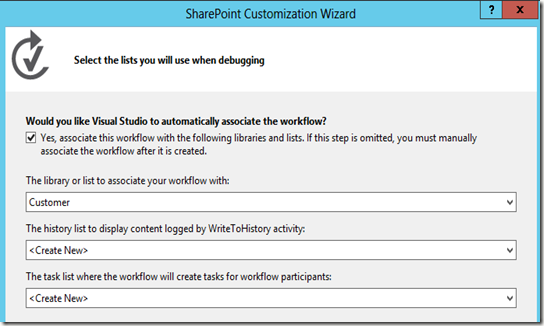This article explains how to create a Custom Code Activity and how to use it in Visual Studio 2013 Workflows for SharePoint 2013.
Implementation Procedure
Implementation Procedure
- Open Visual Studio 2013 and create a new project as Activity Library from the Workflow category and provide the name as CustomListCreation.

- Click Ok. Then right-click on Activity1.xaml and select delete to remove the XAML file, since we are going to create a code activity.
- Right-click on the CustomListCreation project and add a new item as Code Activity from the workflow installed category and provide the name as CustomListCodeActivity.
- Then you will see the following code in the CustomListCodeActivity.cs file.

- Add a reference as Microsoft.SharePoint.Client.dll and Microsoft.SharePoint.Client.Runtime.dll from the ISAPI folder (C:\Program Files\Common Files\microsoft shared\Web Server Extensions\15\ISAPI)
- To allow default qualification of the Microsoft.SharePoint.Client namespace use the following directive:
using Microsoft.SharePoint.Client; - Then create the variable as in the following screenshot.

- Then write the code inside the Execute method.


- Right-click on the project and select Properties and do the following procedure.
- Select Signing
- Check the Sign the assembly checkbox
- Choose New from the drop down

- Then provide the Key file name as CustomListKey and uncheck the Protect my key file as in the following:

- Save the project and close the properties window.
- Build the project and you will see the Build succeeded message.
- Right-click on the project and add a new item as XML File under Data category and provide the name as AllowedTypes.xml.

- Type the following code in the XML file.

- Next we will do the deployment.
- Copy CustomListCreation.dll from the debug folder and paste into the following location.

- Copy the AllowedTypes.xml file from the project folder and paste into the above two locations.
- Open a command prompt to restart the “Workflow Manager Backend” service.
- Type net stop “Workflow Manager Backend” and you will see the message as below.

- Then type net start “Workflow Manager Backend” and you will see the message as below.

- DeployCustomListCreation.dll file into GAC using gacutil.exe
- Open Visual Studio command prompt and type the following command to execute it.
gacutil /i “C:\FolderName for Project\bin\debug\CustomListCreation.dll” /f
- Then you will see the output as shown below.

- Then reset IIS. Type the command as iisrest in the command prompt.
- Copy CustomListCreation.dll from the debug folder and paste into the following location.
- Next we will use this custom code activity in the project.
- Open the site you want to deploy it and create the list you want (in this example, “WFCodeActivityList” is created).
- Right-click on the project solution and select "New Project…."
- Select "SharePoint 2013 – Empty Project" and provide the name as “WFCustomList”.
- Provide the SharePoint URL and select sandboxed solution and click Finish.
- Right-click on the newly created SharePoint project and add a workflow and new item as shown below.

- Provide the workflow name as WF List Code Activity in the next window and select List Workflow as below.

- Click Next and select the list we created in the step 17 from the drop down list.

- In the history list drop down, select WorkflowHistoryList or select <Create New>
- In the task list drop down, select WorkflowTaskList or select <Create New>. Then the final UI is shown below.

- Click Next and leave it as default selection and click Finish
- Then you will see the designer window and you will see the custom activity in the toolbox as shown below.

- Drag and drop 3 WriteToHistory activities to the Sequence from the toolbox under the SP – Utilities category.
- Select the first WriteToHistory activity from the designer and press F4 to open the properties window and click on the (…) button next to Message.

- Then provide the message as “WF Started” in the Expression Editor window and click Ok.

- Repeat Steps 29 and 30 for the third WriteToHistory activity and provide the message as “WF Completed”.
- Drag and drop the CustomListCodeActivity from the CustomListCreation category between the first two WriteToHistory activities and the final UI is shown below.

- Then select Sequence from the designer and click on Variables to create a new variable.

- In the variable window create a new variable called outputMessage and set the variable type as string.

- Then again click on Variables as we did in the step 33 to close the variable window.
- Select the second WriteToHistory activity from the designer and provide the message as string.Format("Output Message : {0}", outputMessage) – Refer step 29 and 30
- Select CustomListCodeActivity and open the properties window and do the following procedure.
- Provide the value for ListDescription as "My Custom Task List Using WF"
- Provide the value for ListName as "TaskListUsingWF"
- Provide the value for ListTemplateName as "Tasks"
- Provide the value for OutMessage as outputMessage (Assign the variable)
- Provide the SiteURL value as

- Final properties for CustomListCodeActivity

- Rename the feature and deploy the project.
- Then you will see the deployment success message in the output window.

- Then go to the List you have associated the workflow and add new item as “My Item”.

- Click on (…) and select workflows from the list. Since the WF is started manually.

- Click on the link as shown below to start the workflow.

- Again repeat the step 41 and click Started as shown below.

- Refresh the page for a few seconds and you will see the workflow history as shown below.

- Then you will see the custom list created by the workflow is displayed in the Quick Launch as shown below.

- Verify the list name is same as we provided in the step 37.
- That's all…. You have done the custom code activity workflow in SharePoint 2013.




















